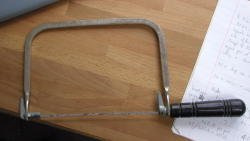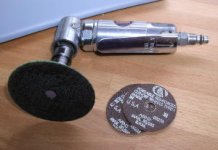Is anyone familiar with companies that will do custom machining/drilling/punching metal work (e.g. on rackmount chasis panels, if you send them the panels alone) at a low/fair cost? I've seen options available from the rackmount enclosure companies like Par Metal and Lansing Enclosures, but they want setup costs of $85-99 per panel (I'd need front and rear only, already almost $200) to use their expensive CNC machining equipment.
Since I don't really have any machining tools, save for a whimpy Dremel and hand drill, I was hoping I could find a service to do the work for me for a professional look.
Since I don't really have any machining tools, save for a whimpy Dremel and hand drill, I was hoping I could find a service to do the work for me for a professional look.
I'm still in the planning stages of most likely a Leach power amp (http://users.ece.gatech.edu/~mleach/lowtim), so I'm just trying to see if it's feasible to acquire all the parts and assemble the amp within a reasonable cost.
The enclosures I have in mind are from Lansing Enclosures, the GrayBox A or B styles:
http://www.lansing-enclosures.com/media/graybox_a_techdata.pdf
http://www.lansing-enclosures.com/media/graybox_b_techdata.pdf
Since I want to keep the amp fairly simple in appearance and assembly, the front and rear panels will only have mounted what's needed:
Front panel - countersunk hole for LED and hole or rectangle for rocker-style power switch.
Rear panel - holes for 2 input RCA jacks, holes for 2 sets of binding posts, rectangles and screwholes for IEC power socket, hole for externally-accessible fuse holder, and holes for wiring to output transistors which are mounted on external heatsinks which are then mounted onto the rear panel via screwholes.
Heatsinks - I'll probably need to have a 1-2 large heatsinks cut down to size to fit the rear panel for the two channels, and have the mounting screwholes drilled into them.
The enclosures I have in mind are from Lansing Enclosures, the GrayBox A or B styles:
http://www.lansing-enclosures.com/media/graybox_a_techdata.pdf
http://www.lansing-enclosures.com/media/graybox_b_techdata.pdf
Since I want to keep the amp fairly simple in appearance and assembly, the front and rear panels will only have mounted what's needed:
Front panel - countersunk hole for LED and hole or rectangle for rocker-style power switch.
Rear panel - holes for 2 input RCA jacks, holes for 2 sets of binding posts, rectangles and screwholes for IEC power socket, hole for externally-accessible fuse holder, and holes for wiring to output transistors which are mounted on external heatsinks which are then mounted onto the rear panel via screwholes.
Heatsinks - I'll probably need to have a 1-2 large heatsinks cut down to size to fit the rear panel for the two channels, and have the mounting screwholes drilled into them.
Possum,
If you are working with aluminum panels, and they are not too thick (like 1/8") you should be able to do what you want with the hand tools you described. Most panel mount devices (RCA input connectors, XLR input connectors, speaker binding posts, IEC connectors, rocker switches, etc.) have flanges around them, so they will look fine from the outside even if the panel hole they are mounted in isn't perfect. It IS tedious to create a rectangular hole for an IEC connector by making "swiss cheese" of the panel with a hand drill, then finishing with a Dremel tool or hand file... but it can be done neatly.
Just a thought.
- Ren
If you are working with aluminum panels, and they are not too thick (like 1/8") you should be able to do what you want with the hand tools you described. Most panel mount devices (RCA input connectors, XLR input connectors, speaker binding posts, IEC connectors, rocker switches, etc.) have flanges around them, so they will look fine from the outside even if the panel hole they are mounted in isn't perfect. It IS tedious to create a rectangular hole for an IEC connector by making "swiss cheese" of the panel with a hand drill, then finishing with a Dremel tool or hand file... but it can be done neatly.
Just a thought.
- Ren
Ren,
Thanks for the advice. I have worked on largish holes and an IEC rectangle hole on a 1/8" aluminum panel before with only my Dremel, and it took quite a long time to cut those out (partly because I wasn't aware that a cutting oil or lubricant would greatly help). However, from the result, I don't think my craftsmanship would be sufficient for such jobs as mainly aligning and drilling mounting holes on the rear panel and heatsinks. Also I'd still need to have a large aluminum heatsink cut to size, which I have have the tools to do.
While I can do some of the tasks, I figured that if I had to have some work done for me, why not have it all done professionally?
BTW, any hints on using Dremel cutting bits through 1/8" aluminum? What I use now are tungsten carbide bits with a libricating oil.
Thanks.
Thanks for the advice. I have worked on largish holes and an IEC rectangle hole on a 1/8" aluminum panel before with only my Dremel, and it took quite a long time to cut those out (partly because I wasn't aware that a cutting oil or lubricant would greatly help). However, from the result, I don't think my craftsmanship would be sufficient for such jobs as mainly aligning and drilling mounting holes on the rear panel and heatsinks. Also I'd still need to have a large aluminum heatsink cut to size, which I have have the tools to do.
While I can do some of the tasks, I figured that if I had to have some work done for me, why not have it all done professionally?
BTW, any hints on using Dremel cutting bits through 1/8" aluminum? What I use now are tungsten carbide bits with a libricating oil.
Thanks.
I never recommend Dremel tool for anything else than wood. It would be much easier to cut aluminum with jigsaw, or if not available hand saw. Just yesterday I cut successfuly a squre opening for AC socket in 3/8 aluminum panel, took me 5min with a drill and jigsaw. Just choose the right blade.
http://www.diyaudio.com/forums/showthread.php?s=&threadid=5948
http://www.diyaudio.com/forums/showthread.php?s=&threadid=5948
Attachments
I also work in an aircraft industry and we cut aluminum daily, when installing patches on aircraft skin. We use high speed grinders, which are way stronger than Dremel, but nobody would use a bit to cut 1/8 aluminum. Those are good for small trimming, if the hole is off center. Preferred cutting tool is a cutting disc and with longer cuts it is quite effective. The discs come in small sizes too and you might be able to install them on a Dremel. But I would recommend a jigsaw.
Attachments
tools & techniques
If you are working with thin (<0.125"), you can also use a sheet metal 'nibbler'. Radio Shack sells them for about $15-20, and it basicall takes a small rectangular 'bite' from an existing hole. This way, you can make accurate square holes. Nibble the hole undersize, and finish with a file.
For larger round holes, I have had success with a 'step' bit. Basically a cone-shaped drill bit, with shoulders for each hole size. The larger ones will do up to 1.25" Most decent hardware shops sell them, but they are $$. As they only have one cutting edge, they leave a very clean hole, with minimal burrs. Much better than normal drill bits. Good for most materials, including sheet steel.
If you are working with thin (<0.125"), you can also use a sheet metal 'nibbler'. Radio Shack sells them for about $15-20, and it basicall takes a small rectangular 'bite' from an existing hole. This way, you can make accurate square holes. Nibble the hole undersize, and finish with a file.
For larger round holes, I have had success with a 'step' bit. Basically a cone-shaped drill bit, with shoulders for each hole size. The larger ones will do up to 1.25" Most decent hardware shops sell them, but they are $$. As they only have one cutting edge, they leave a very clean hole, with minimal burrs. Much better than normal drill bits. Good for most materials, including sheet steel.
Peter,
Thanks for the saw suggestion. Your picture just reminded me of tools I used back in middle school for woodworking and acrylics. If it's that easy to cut thin aluminum with such a tool, then I might as well buy one. Sawing with the handsaw is easy enough (except that I don't have a vice, so I have to use my weight and muscle to keep the parts still).
I've always been a bit wary of using disc cutters. I've used some that came with a Dremel accessory kit to cut plastic, foam, and protoboards, and every once in a while a disc would get caught in the material and shatter, shooting pieces all over (I was lucky to be wearing safety glasses during one of these incidences). For cutting the aluminum, I think I'll stick to the saw method.
I'm aware of your metalwork with chasses from browsing the Pass Labs forums for a bit and value your recommendations.
gilid,
I've once heard of the nibbler a year or two ago, but completely forgot about it. For $15-20, I think it would be a good investment along with a file. I should also look into that step drill bit you mentioned. I know from using a cone-shaped Dremel bit how useful it can be to drill holes for a component of an unknown size, and gradually increase the hole size until the component fits. I've carelessly worn down the Dremel bit once when trying to use it on a hole in 1mm steel. A bit for a hand drill is probably what I should be using. Thanks for letting me know about these.
Thanks for the saw suggestion. Your picture just reminded me of tools I used back in middle school for woodworking and acrylics. If it's that easy to cut thin aluminum with such a tool, then I might as well buy one. Sawing with the handsaw is easy enough (except that I don't have a vice, so I have to use my weight and muscle to keep the parts still).
I've always been a bit wary of using disc cutters. I've used some that came with a Dremel accessory kit to cut plastic, foam, and protoboards, and every once in a while a disc would get caught in the material and shatter, shooting pieces all over (I was lucky to be wearing safety glasses during one of these incidences). For cutting the aluminum, I think I'll stick to the saw method.
I'm aware of your metalwork with chasses from browsing the Pass Labs forums for a bit and value your recommendations.
gilid,
I've once heard of the nibbler a year or two ago, but completely forgot about it. For $15-20, I think it would be a good investment along with a file. I should also look into that step drill bit you mentioned. I know from using a cone-shaped Dremel bit how useful it can be to drill holes for a component of an unknown size, and gradually increase the hole size until the component fits. I've carelessly worn down the Dremel bit once when trying to use it on a hole in 1mm steel. A bit for a hand drill is probably what I should be using. Thanks for letting me know about these.
- Status
- This old topic is closed. If you want to reopen this topic, contact a moderator using the "Report Post" button.
- Home
- Design & Build
- Parts
- Cheap custom machining services?

